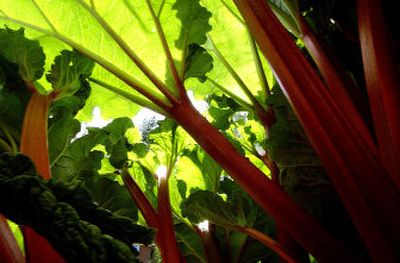Spur your rhubarb’s growth

Can you please advise me what to do to contain the growth of raspberry canes and encourage a healthy crop of raspberries on my mature patch? The canes are as high as 8 feet and presently have eager leaves budding on them. Should the canes be cut down at this time to control the spread and encourage new growth?
A second question: My mature rhubarb plant has for the last two years flowered shortly after it has begun to grow. What suggestions do you have for me to prolong the growing phase of this energetic plant?
Shirley Thomspon, Spokane
Cutting back the tops of the tall raspberry canes doesn’t help control spread. Raspberries spread because they are biennials: If they don’t grow new canes this year, you won’t have any fruit next year. Try this: Decide the boundaries of your raspberry patch. In the early summer after the new canes have come up, dig out any that have strayed outside the boundary. Replant the strongest of these canes to put new blood in your older planting.
Most canes should be cut back to about 6 feet high in the fall or early spring when you thin out the old and small, spindly canes. I usually tie the new shortened canes to a wire to keep them upright for easy picking. This way, it’s also easier to find the tied-up canes when it is time to cut them in the fall.
As for the rhubarb: When the plant sends up a flower, simply snap it off and remove the stalk it is on. This will tell the plant to continue growing leaves. The plant may try to send up another stalk, but just snap that one off, too. An established plant should produce for about two months each year, usually May and June, before the weather gets hot and the plant slows its growth.
Needles nettlesome for mulch
I have a half-dozen pine trees in my large back yard. I would like to try mulching instead of catching my grass clippings. Of course, there are always a certain amount of pine needles in the yard. Is mulching up the pine needles along with the grass going to be good, bad, or immaterial to the lawn condition?
Walt, Spokane
While mulching grass clippings is great to return the nutrients back to the soil and saves you some work, mulching pine needles is going to be problematic. For one thing, it takes a couple of years even for chopped needles to break down, but your grass clippings will break down in a matter of weeks. Therefore, the pine needles will keep accumulating on the lawn and acting like thatch over the long run.
I’d recommend trying mulch-mowing the grass during the summer when the needle drop is slower, and then catch the cuttings during the spring and fall when you get the most needles.